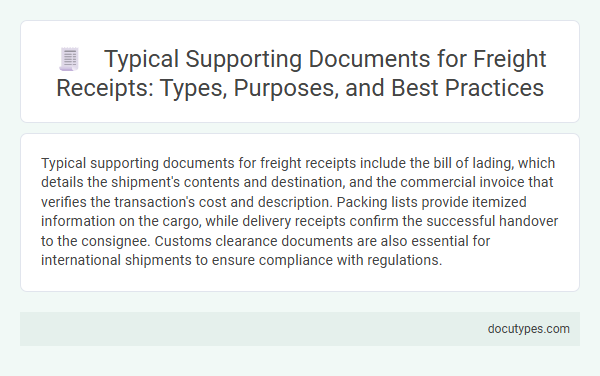Typical supporting documents for freight receipts include the bill of lading, which details the shipment's contents and destination, and the commercial invoice that verifies the transaction's cost and description. Packing lists provide itemized information on the cargo, while delivery receipts confirm the successful handover to the consignee. Customs clearance documents are also essential for international shipments to ensure compliance with regulations.
Introduction to Freight Receipts and Supporting Documents
Freight receipts are essential documents that confirm the shipment and delivery of goods during transportation. Supporting documents provide detailed information to validate the contents, condition, and terms of the freight transaction.
- Bill of Lading - It serves as a contract between the shipper and carrier detailing the shipment specifics.
- Packing List - This document itemizes the contents and packaging details within the shipment.
- Delivery Receipt - It verifies the actual receipt of goods by the consignee, noting any damages or discrepancies.
Proper documentation ensures transparency and accountability throughout the freight shipping process.
Key Types of Supporting Documents for Freight Transactions
Supporting documents are essential for validating freight receipts and ensuring accurate transaction records. These documents provide detailed information about the shipment, delivery, and payment terms.
- Bill of Lading - Serves as a legal contract between the shipper and carrier outlining the goods transported and delivery instructions.
- Invoice - Lists the freight charges, services provided, and payment details related to the shipment.
- Proof of Delivery (POD) - Confirms the receipt of goods at the destination with signatures and delivery date information.
Bill of Lading: Definition and Role
The Bill of Lading is a crucial supporting document for freight receipts, serving as a legal contract between the shipper and carrier. It outlines the type, quantity, and destination of the goods being transported.
This document acts as a receipt of goods, proof of shipment, and a document of title, ensuring the freight is correctly delivered. It plays a key role in resolving disputes and verifying freight receipt details.
Commercial Invoice: Core Details and Importance
Commercial invoices are essential supporting documents for freight receipts, containing critical transaction details such as the seller, buyer, product description, quantity, and price. These invoices serve as proof of sale and are used for customs clearance and tax calculation purposes. Ensuring your commercial invoice is accurate and comprehensive helps facilitate smooth freight processing and accountability in logistics.
Packing List: Contents and Verification Functions
Packing lists are essential supporting documents for freight receipts, detailing the contents of each shipment. They facilitate accurate verification during the receiving process to ensure shipment integrity.
- Itemized Contents - Packing lists provide a detailed breakdown of all items included in the shipment, specifying quantities and descriptions.
- Verification Tool - These documents enable receivers to cross-check the actual goods against the shipment records to confirm accuracy and completeness.
- Damage and Discrepancy Identification - Packing lists assist in detecting missing or damaged items upon delivery, supporting claims and inventory adjustments.
Proof of Delivery (POD): Purpose and Legal Relevance
| Document Type | Description | Purpose | Legal Relevance |
|---|---|---|---|
| Proof of Delivery (POD) | Document signed by the recipient confirming receipt of goods | Verifies that the shipment arrived at the correct destination in acceptable condition | Acts as legal evidence in disputes over delivery, supports invoice validation, and confirms fulfillment of contract terms |
| Bill of Lading | Contract between shipper and carrier outlining shipment details | Serves as a receipt and receipt of goods for transportation | Used as a document of title and legal proof of shipment terms |
| Freight Invoice | Billing statement issued by carrier detailing transportation charges | Ensures accurate payment processing and cost verification | Validates financial transactions and contractual obligations |
| Packing List | Detailed list of items contained in the delivery | Supports verification of shipment contents upon delivery | Assists in resolving discrepancies and legal claims regarding shipped goods |
Insurance Certificates: Risk Protection in Freight
Insurance certificates serve as critical supporting documents for freight receipts, providing proof of coverage against potential risks during transportation. These certificates ensure that the cargo is protected from damages, losses, or theft, offering financial security for all parties involved.
Freight insurance certificates detail the terms and limits of coverage, specifying the liabilities and responsibilities of the insurer and the insured. They are essential for validating claims and facilitating swift resolution in case of incidents during shipment.
Customs Documents: Clearing International Shipments
Typical supporting documents for freight receipts include invoices, packing lists, and customs documents. Customs documents are essential for clearing international shipments and ensuring compliance with import and export regulations. You must provide accurate customs paperwork to avoid delays and additional fees during the shipping process.
Audit and Compliance: Best Records Management Practices
Typical supporting documents for freight receipts include bills of lading, delivery notes, and packing lists. These documents provide essential verification for the goods transported and received.
For audit and compliance purposes, retaining accurate and complete records is critical. Best records management practices involve organizing documents systematically and ensuring they are easily retrievable during audits. Your ability to maintain thorough documentation supports transparency and regulatory compliance in freight transactions.
What Are Typical Supporting Documents for Freight Receipts? Infographic

